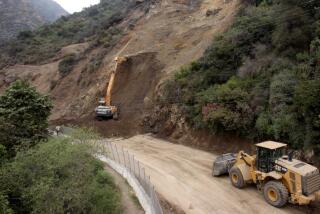Fabled highway set to celebrate its WWII role : Alaska-Canada roadway was built in 1942 after Japan invaded the Aleutians--the only foreign occupation on the continent.
- Share via
FAIRBANKS, Alaska — World War II and the invasion of the Aleutian Island chain by the Japanese 50 years ago is about to bring on another thundering invasion of Alaska--a less hostile invasion by road, up the storied Alaska-Canada Highway.
The interior of Alaska is frozen, dark and mostly quiet this winter. But already there is an abundance of anticipation, preparation, hope--and a good measure of dread--over what adventurous and noisy masses may soon ascend the long ribbon of highway to celebrate its 50th anniversary.
The bulldozing of the mighty road through the North American Rocky Mountain wilderness was probably the most significant convergence of forces in the history of modern Alaska, more important even than the building of the Alaska oil pipeline.
Six months after Japan’s attack on Pearl Harbor brought the United States into World War II, the Japanese, in June, 1942, occupied two remote islands in Alaska’s Aleutian chain in the Bering Sea.
That raised concern about a Japanese land invasion of North America through Alaska.
So, with speed, decisiveness and disregard for anything standing in the way, U.S. and Canadian authorities began to build an overland link to the remote American territory.
According to Alaska historians, about 16,000 construction workers, toiling around the clock through everything from clouds of mosquitoes to subzero freezes, plowed out the 1,422-mile highway in eight months and 12 days. It ran from Dawson Creek, British Columbia, to Delta Junction, Alaska, just south of Fairbanks.
American commanders ultimately dismissed the occupation of Attu and Kiska Islands as a Japanese feint to cover other war activities in the Pacific. And after the invaders were driven out in 1943 by American and Canadian forces, the Aleutian campaign became known as the “Forgotten War.”
National Park Service historian Sande Faulkner says there is another perspective on the engagement. “From the Japanese point of view, you cannot set aside the value of having troops on U.S. soil on the American continent. It had great psychological effects in Japan.”
Out on the Aleutian Islands this year, the National Park Service is studying the artifacts and sites of the only Japanese occupation of American land on the continent. Recommendations for the future preservation of the battlefields and possible National Historic Park status are expected to go to Congress before the year is out.
There is no debating that vast changes--both good and bad--were wrought by the Alaska-Canada highway.
The war and the road combined to create a population explosion in the region and to give Alaska the national prominence that led to its entry into the Union as the 49th state in January, 1959.
In its building, workers spread contagious disease among the natives of the north country, and the subsistence culture of the people was forever disrupted.
Since then, webs of roads and civilization have spread in all directions from the highway, and a flourishing commercial and tourist trade route has become famous the world over.
Last year, 80,000 vacationers drove the two-lane road, which is sometimes called the last great driving adventure remaining in North America. This year, with both Alaska and Canadian commissions actively promoting the anniversary, the figure is expected to be 30,000 higher.
“The first two words are ‘mystery’ and ‘magic’--that’s what comes to me when I think of the road. And I was born here in Alaska,” says Susan C. Kemp, executive director of the Great Alaska Highways Society.
But tourist officials worry that the celebration, which kicks off in Dawson Creek on Feb. 15, will pose problems for the unwary. Peak summer tourist travel on Alaska roads often means traffic jams, miles of no-vacancy signs, road stops piled with human waste and long waits for everything from dinner reservations in Anchorage to seats on the buses that take sightseers into Denali National Park.
Not knowing exactly how much additional traffic actually will venture along the road, tourism leaders have prepared plans that would allow emergency use of public facilities in the event of severe overcrowding.
Apart from tourism, the 50th anniversary of the war and road has stimulated resurgent interest in Alaska’s colorful history. And along the way, attention is being paid to some of those whose contributions were previously understated. For example, three regiments of black Army engineers did more than a third of the incredibly difficult work of plowing the road through.
Survivors of the black regiments met last weekend for their own 50th anniversary celebration--in Florida.
More to Read
Sign up for Essential California
The most important California stories and recommendations in your inbox every morning.
You may occasionally receive promotional content from the Los Angeles Times.













